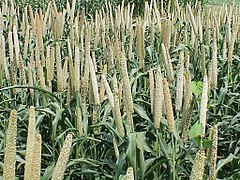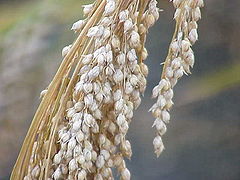చిరుధాన్యం: కూర్పుల మధ్య తేడాలు
Rajasekhar1961 (చర్చ | రచనలు) |
Rajasekhar1961 (చర్చ | రచనలు) |
||
| పంక్తి 57: | పంక్తి 57: | ||
[[Image:Millet.png|thumb|150 px|millet]] |
[[Image:Millet.png|thumb|150 px|millet]] |
||
==పోషక విలువలు== |
|||
==Nutrition== |
|||
The protein content in millet is very close to that of [[wheat]]; both provide about 11% protein by weight. |
The protein content in millet is very close to that of [[wheat]]; both provide about 11% protein by weight. |
||
04:40, 15 మార్చి 2009 నాటి కూర్పు

చిరుధాన్యాలు లేదా తృణధాన్యాలు (Millets) ఆహారధాన్యాలలో చిన్న గింజ కలిగిన గడ్డిజాతి పంటలు. వీటిని ప్రపంచవ్యాప్తంగా ఆహారం కోసం మరియు పశుగ్రాసం కోసం పెంచుతున్నారు. ఇవి ఒక శాస్త్రవిభాగం కాదు; వీటి సామాన్య లక్షణం చిన్న విత్తనాన్ని కలిగియుండడం మాత్రమే. ఇవి నీరు తక్కువగా అందే మెట్టప్రాంతాలలో పండి, పేదదేశాల ప్రజలకు ఆహారపు అవసరాల్ని తీరుస్తాయి.
చిరుధాన్యాలలో రకాలు

చిరుధాన్యాలలో చాలా జాతుల మొక్కలు పోయేసి (Poaceae) కుటుంబంలో ముఖ్యంగా పానికోయిడే(Panicoideae) ఉపకుటుంబంలో ఉన్నవి.
వీనిలో ప్రపంచవ్యాప్తంగా ప్రాముఖ్యత ననుసరించి ముఖ్యమైన జాతులు[1] are.:
- Pearl millet (Pennisetum glaucum)
- కొఱ్ఱలు (Setaria italica)
- Proso millet also known as common millet, broom corn millet, hog millet or white millet (Panicum miliaceum)
- రాగులు (Eleusine coracana)
ఇతర తక్కువ ప్రాముఖ్యత కలిగిన చిరుధాన్యాలు:
- Barnyard millet (Echinochloa spp.)
- Kodo millet (Paspalum scrobiculatum)
- Little millet (Panicum sumatrense)
- Guinea millet (Brachiaria deflexa = Urochloa deflexa)
- Browntop millet (Urochloa ramosa = Brachiaria ramosa = Panicum ramosum)
- Teff (Eragrostis tef)
- fonio (Digitaria exilis)
- జొన్నలు (Sorghum spp.)
- Job's Tears (Coix lacrima-jobi).
చిరుధాన్యాల ఉపయోగాలు

Millets are major food sources in arid and semi-arid regions of the world. In Western India, millet flour (called "Bajari" in Gujarati and Marathi) has been commonly used with "Jowar" (Sorghum called "Jowar" in Marathi) flour for hundreds of years to make the local staple flat bread (called "Rotla" in Gujarati or "Bhakri" in Marathi).
Millets are traditionally important grains used in brewing millet beer in some cultures, for instance by the Tao people of Orchid Island and, along with sorghum, by various peoples in East Africa.
Millet is used to prepare boza fermented drink in Balkan peninsula countries.
Millet is the base ingredient for the distilled liquor rakshi in Nepal and the indigenous alcoholic drink of the Sherpa, Tamang and Limbu people tongba in Eastern Nepal.
Millet porridge is a traditional Russian food, eaten sweet (with milk and sugar added at the end of cooking process) or savoury with meat or vegetable stews.
Millet porridge is a traditional Chinese food, eaten without milk or sugar. Frequently beans, sweet potato, and / or various types of squash will be added.
Coeliac patients can replace certain cereal grains in their diets by consuming millets in various forms including breakfast cereals.
Millet can often be used in recipes instead of buckwheat, rice, or quinoa.
Millet sprays are often recommended as healthy treats to finicky pet birds, as they are easily eaten and (in the case of destruction-prone hookbills) easily broken.
Millet, along with birdseed, is commonly used as fillings for juggling beanbags.

పోషక విలువలు
The protein content in millet is very close to that of wheat; both provide about 11% protein by weight.
Millets are rich in B vitamins, especially niacin, B17 (see nitrilosides), B6 and folic acid, calcium, iron, potassium, magnesium, and zinc. Millets contain no gluten, so they are not suitable for raised bread. When combined with wheat or xanthan gum (for those who have coeliac disease), however, they can be used for raised bread. Alone, they are suited for flatbread.
As none of the millets are closely related to wheat, they are appropriate foods for those with coeliac disease or other forms of allergies/intolerance of wheat. However, millets are also a mild thyroid peroxidase inhibitor and probably should not be consumed in great quantities by those with thyroid disease.
The basic preparation consists in washing the millet and toasting it while moving until one notes a characteristic scent. Then five measures of boiling water for each two measures of millet are added with some sugar or salt. The mixture is cooked covered using low flame for 30-35 minutes.
మూలాలు
- ↑ "Annex II: Relative importance of millet species, 1992-94". The World Sorghum and Millet Economies: Facts, Trends and Outlook. Food and Agriculture Organization of the United Nations. 1996. ISBN 92-5-103861-9.
- Crawford, Gary W. Paleoethnobotany of the Kameda Peninsula. Museum of Anthropology, University of Michigan, Ann Arbor, 1983.
- Crawford, Gary W. Prehistoric Plant Domestication in East Asia. In The Origins of Agriculture: An International Perspective, edited by C.W. Cowan and P.J. Watson, pp. 117-132. Smithsonian Institution Press, Washington, 1992.
- Crawford, Gary W. and Gyoung-Ah Lee. Agricultural Origins in the Korean Peninsula. Antiquity 77(295):87-95, 2003.